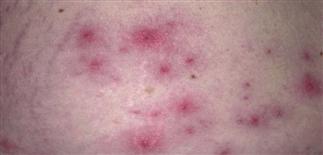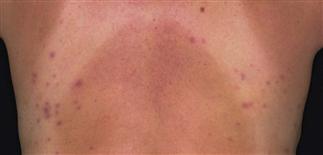51
Pseudomonas folliculitis

The primary lesion in Pseudomonas folliculitis is the pustule. It is follicular with a bright red halo surrounding it. There is usually a history of recent hot tub use.

Bright-red swollen macules with a central pustule on the trunk. Pseudomonas folliculitis is typically under the area covered by a bathing suit. It is often pruritic.

Pseudomonas folliculitis of the buttocks. Bright-red macules with central pustules. The lesions are all in the same stage of evolution. A culture is helpful. Note similarity of lesions.

Scattered inflammatory papules that are nearly resolved, concentrated in the area that was covered by the bathing suit.
DESCRIPTION
Pseudomonas folliculitis is an acute, superficial skin infection that follows exposure to contaminated water. The urticarial red plaque with a central papule or pustule is highly distinctive. Multiple lesions on the trunk are typical. Also called hot tub folliculitis.
HISTORY
• Attack rate significantly higher in children than in adults, possibly because children tend to spend more time in the water. • Occurs 8 h to 5 days (or longer) after using a contaminated pool (whirlpool, hot tub, physiotherapy pool) or water slide, or a contaminated loofah sponge. The attack rate is variable; 7–100% of those exposed to Pseudomonas species develop the disease. • Spread of infection from person to person is unlikely. • Prolonged exposure to water, excessive numbers of bathers, and inadequate pool or spa care predispose to infection. • Desquamated skin cells in the water provide a rich, organic nutrient source for bacteria. • In most cases, eruption clears in 7–10 days without treatment, but recurrent crops of lesions may occur for as long as 3 months.
PHYSICAL FINDINGS
• Plaques are 0.5–3 cm, red, pruritic, round, and urticarial with a central papule or pustule. • Sudden onset. A few plaques to more than 50 occur primarily on trunk. • Rash may be a follicular, maculopapular, vesicular, pustular, or polymorphous eruption including all these lesion types. • Rash most severe in areas occluded by snug bathing suits. • Occlusion and superhydration favor colonization of skin with Pseudomonas aeruginosa. • Women who wear one-piece bathing suits at an increased risk. • Rash resolves, leaving round macules of postinflammatory hyperpigmentation. • Fever, malaise, and fatigue may occur during initial few days of eruption, but this is uncommon. • P. aeruginosa serotypes 0:9 and 0:11 are most commonly isolated from skin lesions.
TREATMENT
• Infection self-limited; treatment usually not required. • Other treatment options: A wet dressing of acetic acid 5% (white vinegar) is applied for 20 min b.i.d. or q.i.d. Silver sulfadiazine cream (Silvadene) can help. • Cases resistant to topical therapy can be treated orally with ciprofloxacin (Cipro) 250–500 mg b.i.d. for 7 days. • Preventive measures: continuous water filtration eliminates desquamated skin; maintain adequate chlorine levels; change water in private hot tubs every 4–8 weeks; drain public hot tubs daily. • Showering after using the contaminated facility offers no protection.







